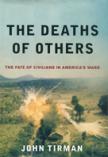Blood on Our Hands?
We recently entered the age of the fighting drone. The U.S. military now stockpiles and deploys thousands of computerized airborne drones of many sizes, from blimp-like contraptions to the aptly named Hummingbird, smaller than your hand. All undertake stealthy surveillance of enemy targets. The largest remote-controlled devices launch missiles with enough firepower to destroy vehicles and entire building complexes. We have been hearing about successful hits on terrorists delivered by drones for years now in places like Yemen, Afghanistan and Pakistan.
But recent media reports also recount disturbing instances of errant drone strikes that kill innocent civilians and even allies. The tactical advantages of unmanned drones (fewer U.S. lives in harm’s way) are accompanied by new perils of missions gone awry, when highly touted precision weapons fail to live up to their promise. The challenges surrounding the use of new generations of drones prove to be not only technological in nature, but moral as well.
There is scant mention of aerial drones in John Tirman’s stunning new book The Deaths of Others. For the most part, it focuses on much earlier events, with data-packed chapters on the deaths of civilians in World War II, Korea, Vietnam and the early years of U.S. involvement in Iraq.
But the analysis contained in its sweep through the history of American interventions abroad is directly relevant to our new age of drone warfare. The same ghastly dynamic has been at play time and again: powerful weapons, aggressive military strategies and rules of engagement calculated to save the lives of U.S. service personnel often wind up causing the deaths of many innocent civilians in the lands where these military conflicts unfold.
At the heart of this volume from John Tirman, a distinguished M.I.T. researcher in international studies, is that most Orwellian of phrases: collateral damage. Surgical strikes and precision weapons are chimeras. Despite explicit provisions of Geneva Conventions that claim the force of international law, many nations fail to enact adequate measures to prevent civilian casualties during armed conflicts. Is it fair to call these atrocities and violations intentional? The answer to this pivotal question lies in a shadowy territory that involves matters far beyond actual battlefield conduct.
Tirman limits his analysis to the United States, probably a wise decision for a single-volume study, although comparison to other nations’ war-fighting histories might prove illuminating. To explain why a generally compassionate, even idealistic nation like the United States so frequently fails to enact adequate civilian protection, the author delves into features of U.S. culture that will make many readers uncomfortable. One is the perennial raw nerve of racism. Prevailing negative stereotypes of Asians and Arabs have played a palpable role in the framing of military rules of engagement that tolerated or directly caused great loss of civilian life in Korea, Vietnam and Iraq. The author supports his case by providing chilling investigations into the atrocities at No Gun Ri, My Lai and Haditha, each constituting direct and clearly unjustified killing of unarmed civilians by U.S. forces.
A more diffuse set of explanatory causes resides in even deeper recesses of U.S. attitudes toward the rest of the world. Drawing upon numerous social critics, including his mentor Howard Zinn, Tirman highlights a “frontier myth” that exerts great sway over U.S. policy even today. A resulting strain of American exceptionalism leaves little room for self-doubt and contributes to a political culture that too readily justifies reactive violence against perceived threats to the imagined proper order of civilization, or even a divinely ordained destiny. Relying on an analysis of cultural archetypes like this to explain policy directions is neither an original contribution nor a stance likely to go undisputed, but Tirman lays out his strenuously argued case with considerable cogency.
Besides the author’s documentation of the sheer magnitude of death-dealing in direct and indirect ways, the most disturbing revelations of this book pertain to how the American public invents ways to ignore the blood on its own hands. The key observations in this regard fall under Tirman’s analytic category of “the epistemology of war.” Of course, the natural inclination is to focus our attention on the loss of U.S. lives, though our war casualties are usually few compared with those of other nations. But our psychological coping strategies, defense mechanisms and willful obliviousness regarding preventable harm wrought to civilians in advancing U.S. objectives cry out to be exposed.
Most media outlets also avert their eyes, willing accomplices to our endemic blindness. As if to reveal a glimmer of a silver lining in this dark cloud of a book, Tirman lifts up a variety of heroes (investigative journalists during the Vietnam War, public health professionals calculating credible body counts of Iraqi civilian casualties over the past 20 years of deadly sanctions and occupation) who display the courage lacking in most of us, who refuse to face up to ugly truths.
Tirman renders us great service by providing a fuller picture of the consequences of war and challenging us not to reject data simply because it is not congruent with our favored worldview. Admittedly, spending time with this book may obscure two important facts: that the U.S. military ordinarily comports itself quite commendably, and that the American public is generally quite compassionate to the war victims it does acknowledge. But neither military practices nor public attitudes should be insulated from all criticism.
The advent of aerial drone bombers offers a new opportunity to reject unethical means, even those employed in pursuit of justifiable military goals. If Americans today marshal the resolve to enact workable norms ensuring that our use of drones will always discriminate between civilians and legitimate enemy targets, then we will at last be facing up to the crucial moral questions raised in this book.
This article also appeared in print, under the headline “Blood on Our Hands?,” in the October 3, 2011, issue.








